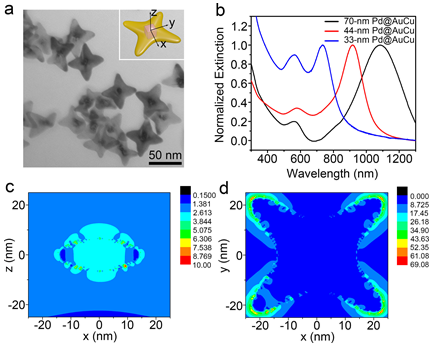Breakthrough in the Localized Surface Plasmon Resonance of Metal Nanocrystals with Low Symmetry
Recently, the research group of Prof. Zeng from Hefei National Laboratory for Physical Sciences at the Microscale & School of Chemistry and Materials Science has made significant progress in the localized surface plasmon resonance of metal nanocrystals with low symmetry. Through integration of kinetic control and lattice mismatch, researchers successfully fabricated Pd@AuCu core-shell planar tetrapods with adjustable in-plane dipole resonance from visible to near-infrared region. Due to the low symmetry, together with the presence of abundant tips and edges in the branches, such planar tetrapods exhibited excellent surface-enhanced Raman scattering performance. This work has been published on Nano Letters (Nano Letters, 2016, 16, 3036-3041) with the title of “Integration of Kinetic Control and Lattice Mismatch to Synthesize Pd@AuCu Core-Shell Planar Tetrapods with Size-Dependent Optical Properties”.

Pd@AuCu core-shell planar tetrapods and their localized surface plasmon resonance properties
Symmetry can alter the surface charge distribution and polarization of free electrons in the metal nanocrystals, and thus determine their localized surface plasmon resonance. Typically, compared with polyhedral nanocrystals confined in the cubic symmetry, planar nanocrystals contain extended resonance modes with both in-plane and out-of-plane dipole plasmon modes. Among different kinds of planar nanocrystals, planar branched nanocrystals possess a variety of tips and edges that can serve as hot spots for large electric-field enhancement, contributing to the promising localized surface plasmon resonance-assisted applications. However, the preparation of planar branched nanocrystals requires the selective growth of branches in two dimensions and thus is of great challenge.
Based on Pd nanocubes with Oh symmetry as the initial seeds, researchers successfully obtained Pd@AuCu core-shell planar tetrapods with D4h symmetry through integration of kinetic control and lattice mismatch. With the manipulation of sizes, the peak position of in-plane dipole resonance can be adjusted from visible to near-infrared region. Branched structures endow the planar tetrapods with sufficient tips and edges, thereby enabling excellent surface-enhanced Raman scattering performance with an enhancement factor up to 9.0 × 103 for 70 nm Pd@AuCu planar tetrapods. This work provides a novel insight in the research of localized surface plasmon resonance for metal nanocrystals with low symmetry.
>This work was supported by MOST of China and the National Natural Science Foundation of China.
Publication link: http://pubs.acs.org/doi/abs/10.1021/acs.nanolett.6b00002
QQ图片20160516170521.png
Back
